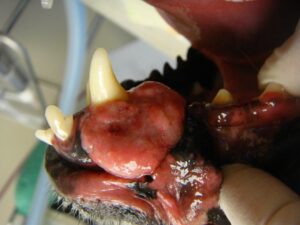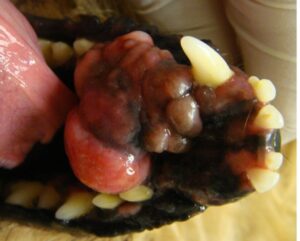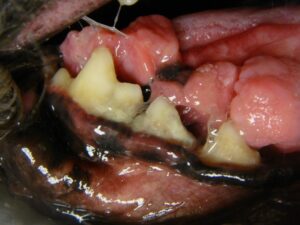
15 Sep Oral Tumors in Dogs and Cats
Neoplasia is always a frightening subject for pet owners. You may have had cancer yourself or have experienced it with a friend or family member. It’s normal to worry and imagine the worst possible outcome. Early diagnosis and treatment greatly improve the prognosis for most oral tumors in dogs and cats so all growths in the mouth should be addressed with urgency. There are also many oral masses that can look like neoplasia so it’s important to get a biopsy to know the difference.
What is Neoplasia?
Neoplasia is the term used to describe both malignant and benign tumors. Malignant tumors, or cancer, are ones that can metastasize (spread to other parts of the body) and are therefore more difficult to treat. Benign tumors are not cancerous. They cannot spread to other parts of the body, but they can grow very large and can invade into deeper tissues such as bone. The oral cavity is the fourth most common site for neoplasia in dogs and the third most common for cats.
The Importance of Early Detection
Early detection is key for a good outcome. Besides helping to prevent periodontal disease, daily toothbrushing can mean that a new growth in the mouth is noticed before it gets too big. Whenever your dog or cat gets a check up at your primary care veterinarian, an awake oral exam should be performed. And when your pet gets a dental cleaning, that is an even better time to look closely for any abnormal tissue. Because we don’t know what causes most oral tumors, it’s hard to recommend any forms of prevention. The one exception is cats with oral squamous cell carcinoma, the most common oral malignancy in cats. Oral SCC has a poor prognosis in cats no matter the treatment. Cats who live with smokers have a higher incidence of oral SCC so that’s one of many good reasons to quit!
In general, oral tumors require a biopsy taken under general anesthesia to get an accurate diagnosis which is critical for understanding the prognosis and making a plan for treatment. At Animal Dental Care & Oral Surgery, we use a veterinary pathologist who specializes in oral disease (Home (sopforanimals.com)) to get the best possible information. A CBCT scan can be performed at the same time as the biopsy to get an idea of how invasive a growth is. Malignant tumors grow quickly and can be painful. If malignancy is suspected, less invasive tests such as a chest x-ray, lymph node testing or abdominal ultrasound may be recommended before biopsy.
Treatment Options
Treatment options for oral tumors depend on the type. The most common benign oral growth in dogs is called peripheral odontogenic fibroma (see image a). Although these growths on the gum tissue can get quite large, they can be cured with surgery. Sometimes the associated tooth must be extracted to prevent recurrence. A common benign but invasive tumor in dogs is called canine acanthomatous ameloblastoma (see image b). CAA can also be cured by surgery, but because this tumor invades the underlying bone, some bone must be removed as well. Another type of neoplasia that responds well to surgery is squamous cell carcinoma in dogs. Unlike in cats, oral SCC in dogs has an excellent prognosis with surgery.

Image A: Peripheral odontogenic fibroma in a dog

Image B: Canine acanthomatous amelolastoma
Types of Oral Growths
Malignant tumors can be more difficult to treat because they can metastasize and may regrow after surgery. The most common malignant oral tumor in dogs is malignant melanoma (see image c). Dogs can also get a type of fibrosarcoma that looks benign under the microscope but behaves aggressively. Sometimes more than one biopsy and scan may be needed to make the diagnosis. Osteosarcoma can affect any part of the skeleton. Fortunately, when it grows in the mouth, it is easier to treat than when it grows in other areas. For tumors that respond to radiation treatment, we are fortunate to have a facility right here in Fort Collins: Pet Cancer Treatment Options: Radiation – Flint Animal Cancer Center (csuanimalcancercenter.org)

Image C: Malignant melanoma in a dog
Even very young animals can get oral cancer as well as non-cancerous growths that require surgery. Papillary SCC (see image d) can occur in very young dogs but has an excellent prognosis if removed surgery. Although SCC is a malignancy, this form of it is not known to metastasize. Odontomas are also found in young animals. These are growths made up of disorganized dental cells. In compound odontomas, the growth may contain numerous tiny teeth called denticles. This bizarre growth is not a true cancer but should be removed surgically to stop it from enlarging. Mandibular periostitis ossificans is a condition that has been described in young large-breed dogs. It causes swelling of the lower jaw but can resolve without treatment.

Image D: Papillary SCC in a young dog
True cysts in the bone can occur in the jaws of animals. The dentigerous cyst is the most common and is caused by unerupted teeth. Dentigerous cyst formation can occur at any age and will progress in size, destroying the surrounding bone and teeth. Removal of the unerupted tooth as well as the cyst lining is curative. These lesions are not grossly visible until they have already caused significant damage and that’s why we recommend removing unerupted teeth as soon as they are found.
Non-neoplastic lesions can look like cancer. They can form masses in the oral cavity, create ulceration, odor and pain and can even distort bone. Examples include benign gingival enlargement secondary to certain prescription drugs or due to genetics (Boxers are predisposed). Pyogenic granuloma in cats can mimic SCC but is just swollen, inflamed tissue secondary to traumatic contact with teeth in the opposing jaw. Mucosal granulomas (see image e) consist of proliferative and sometimes ulcerated tissue that can form on the inside of the cheek or under the tongue in dogs. Some cats can get enlargement of the bone around their canine teeth in response to dental disease. While this looks scary, it can be treated by removing the diseased teeth.

Image E: Mucosal granulomas under the tongue of a dog
This article provides only a brief overview of types of oral tumors in cats and dogs. There are many more that may be found in a dog or cat’s mouth. Before deciding on a course of action, consider reaching out to a board-certified veterinary dentist™ to get some expert advice. We can help you get the correct diagnosis and review all options for treatment. We can also offer palliative care when that is the best decision for you and your pet. And please check your pet’s mouth regularly for anything out of the ordinary. The sooner we identify a problem, the easier it is to treat!



